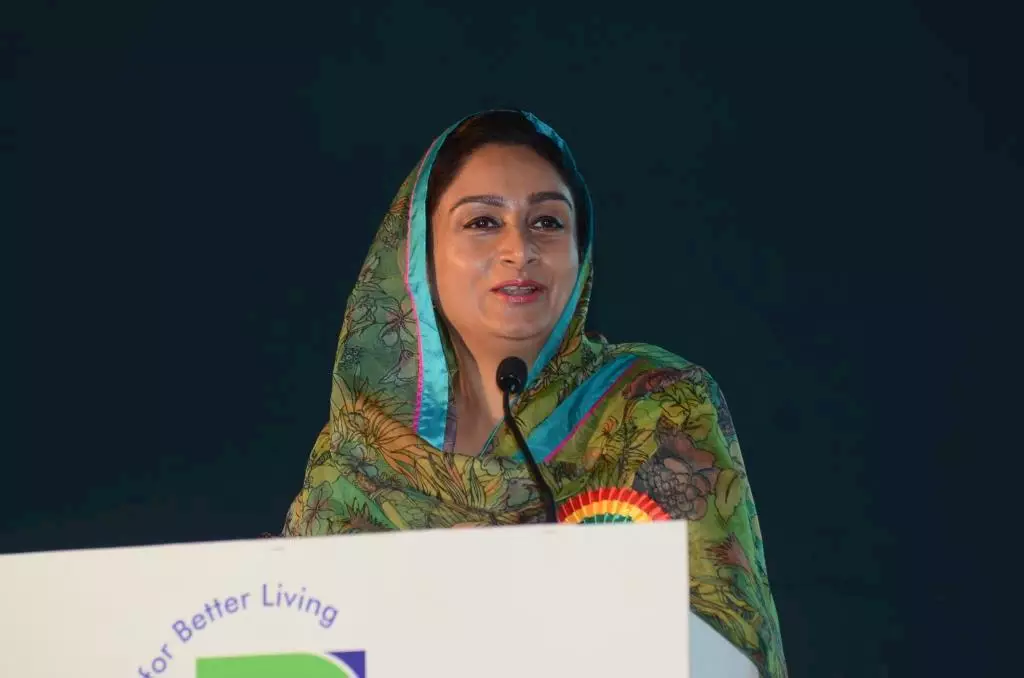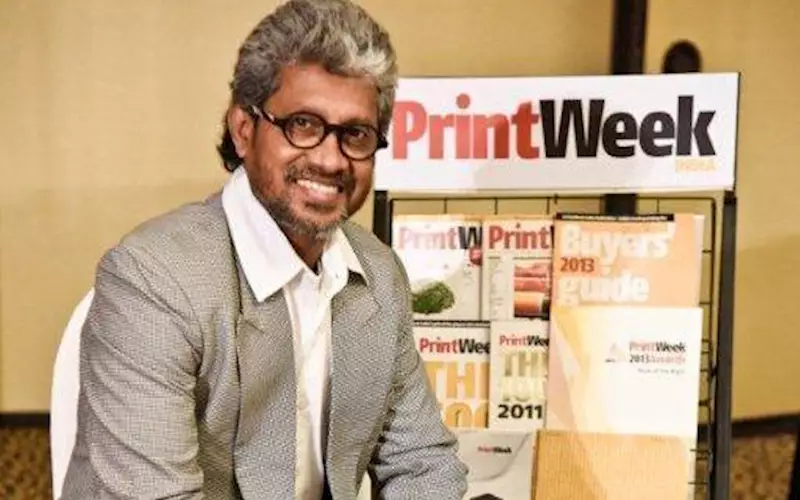Packaging Power: Ten talking points from World Packaging Congress
200 exhibitors, 1200 delegates, a slew of announcements; as the Indian packaging industry gallops towards USD 43.7bn. The Sunday Column looks at the top talking points and chatter among the big daddies in the industry
10 Oct 2015 | By Noel D'Cunha

In an extempore address to the World Packaging Congress (WPC) gathering, the union food processing minister Harsimrat Kaur Badal highlighted the government’s commitment to 42 mega food parks (MFP) which could be operational by 2019. A rough estimate suggests this will yield a potential investment of about Rs 14,000 crore and should benefit 12.5 lakh farmers plus generate 3-4 lakh new jobs, too.
Chalo Vizag
The state government of Andhra Pradesh has set up a pavilion at the Indiapack exhibition so that the industrial visitors will have an opportunity to understand the investment opportunity in Andhra Pradesh. This is in line with January announcement of packaging park in Vizag. According to Rajani Ranjan Rashmi, additional secretary, the ministry of commerce and industry, Government of India, "The present state government of Andhra Pradesh is very enthusiastic about it. We identified one place called Gambhiram, with an area of 10-acre and located opposite the IIM. Further, we have received a letter from the Andhra Pradesh Industrial Infrastructure Development Corporation. They have identified a 100-acre land in a place called T Sirsapalli for packaging. The state government of Andhra Pradesh wants IIP to be a part of it."
Boom in liquid packaging
Kandarp Singh, managing director from Tetra Pak South Asia Markets, spoke about how aseptic packaging is sustainable and easy to recycle. Tetra Pak is stressing their recycle and reuse initiative. This is visible at their kiosk at Indiapack plus during the presentation. In addition, at the kiosk one can see Tetra Pak substrates being recycled into diaries, roof tiles etc. The facility in Chakan which produces materials for Tetra Pak's aseptic packaging products is the second largest facility in the world after Sweden.
During the opening ceremony a lot of other numbers were crunched. One eye popping stat that emerged was: how the liquid packaging business has a tremendous potential not only in India but also globally. Pundits say, we are seeing a growth of 20 percent in this segment. At present, the Indian market stands at eight billion packs made out of this packaging material per year. This would double in next four to five years.
Aseptic packaging is expected to play a key role with agro commodities. This is one of the big themes of the Government of India. And this theme resonated with the remarks by Rajani Ranjan Rashmi, additional secretary, ministry of commerce and industry during his opening address.
Rs 1500 cr Uflex investment in Sanand
Speaking of aseptic packaging, a big news from this segment emerged on the eve of the show: the Uflex plan to set up a Rs 1500 cr factory at Sanand (Gujarat). The company would invest around Rs 580 crore in the first phase to set up an aseptic (sterile) packaging line that would employ 250 people. While the capacity in the initial phase would be around 3.5 billion packs, it would be increased up to seven billion packs over time. This underscores the importance of the liquid packaging business.
Metal: choice of premium packaging

Daga said, “Flexibility and mouldability, those are important. That is a little difficult with metal. But if it is rigidity, perhaps the protective barriers that metal offers become important. UV rays cannot penetrate through the metal and recyclability is another important factor, where metal scores.”
IIP dazzles with one patent
IIP director Dr NC Saha is proud of his team’s performance. Rightly so, thanks to their efforts the institute has earned its first patent. There is a product in West Bengal called Jaggery, which is produced from sugarcane. In West Bengal (WB) there is a fruit available called palm. From the palm you make the ‘gur’ and it is called nullen gur. It is available in West Bengal from November to March. Normally it is sold in solid form. New trend is liquid gur. West Bengal government has started a new mission called Vishva Bangla, which is a retail chain. The product (gur) shelf life is only three hours.
Saha narrates: We analysed the critical factors that stales the product. We filled the warm gur in various packaging materials. The material should be strong to prevent the affect on environment. We had chosen three options – stand-up pouch with spout, coextruted plastic bottle (like tomato ketch-up) and multiwall collapsible plastic tube (like toothpaste) – three-layer aluminium barrier tube with induction seal which extended the shelf life from three hours to 92 days. The sale of Vishwa Bangla has gone up, many NRIs buy the product in dozens. They launched 200ml labelling it as natural date palm by IIP and Ministry of cottage and micro industry of govt of west Bengal.
This is IIP's first patent.
It’s a great time to be a packaging professional
 I like numbers, especially when they start appearing bullish. WPO president Thomas Schneider told us, the compound annual growth rate for packaging world-wide is projected at 4.1% on an annual basis through 2018. And by 2018, the sale of packaging products will approach $1 trillion US dollars. And within the eight distinct regions that PIRA studied, Asia has the highest rate of 6.3% per year. Finally, of all the countries in Asia included in this study, India is projected to have the highest growth rate… 10.7% per year through 2018. This is a phenomenal growth rate and will be difficult to sustain without more focused education for future packaging professionals and users of packaging materials and machinery. This is due, in large part, because of the growth of the middle class. Typically, in a modern, first-world society, the middle class is the largest population segment; and India is evolving no differently.
I like numbers, especially when they start appearing bullish. WPO president Thomas Schneider told us, the compound annual growth rate for packaging world-wide is projected at 4.1% on an annual basis through 2018. And by 2018, the sale of packaging products will approach $1 trillion US dollars. And within the eight distinct regions that PIRA studied, Asia has the highest rate of 6.3% per year. Finally, of all the countries in Asia included in this study, India is projected to have the highest growth rate… 10.7% per year through 2018. This is a phenomenal growth rate and will be difficult to sustain without more focused education for future packaging professionals and users of packaging materials and machinery. This is due, in large part, because of the growth of the middle class. Typically, in a modern, first-world society, the middle class is the largest population segment; and India is evolving no differently.
MAP can increase shelf life
Modified atmosphere packaging (MAP) to increase shelf life by delaying oxidation and degradation, was a topic of interest among many. It was heavily deliberated up on at the WPC. Apio USA has developed special films which alter the oxygen-carbon dioxide content.
Plus they have developed ideal oxygen carbon dioxide ratio for each kind of food item and can have packaging materials which can maintain those conditions without reaching the anaerobic state. They call this technology breatheway. They are claiming shelf life increase of up to 60 days on some types of fresh produce.
Effectively this means, manufacture lemons in September and sell them in November when there is better demand. The company is the largest food processor in North America and says food processing opens up new business models and markets.
POSTCRIPT
Pragati sweeps IndiaStar
Even as I was penning my Sunday Column, my young colleagues, Tanvi Parekh, Priya Raju and Monica Rohra who were attending the gala award ceremony for the IndiaStar Awards 2014-15 on 10 October; informed me that Pragati has scored with 32 Awards. A total of 262 awards were conferred to 101 companies. Among them, top five winners of the evening were Pragati Pack (32 Awards), ITC (17), Hindustan Unilever (16), Huhtamaki PPL (10), and Jayna Packaging (10).













 See All
See All